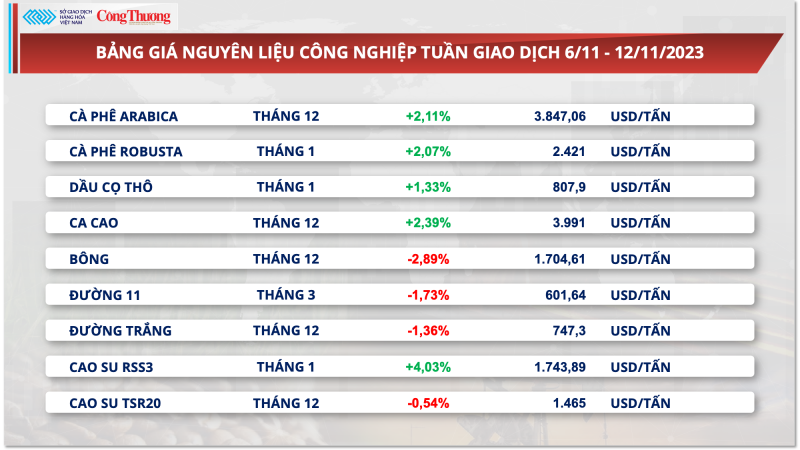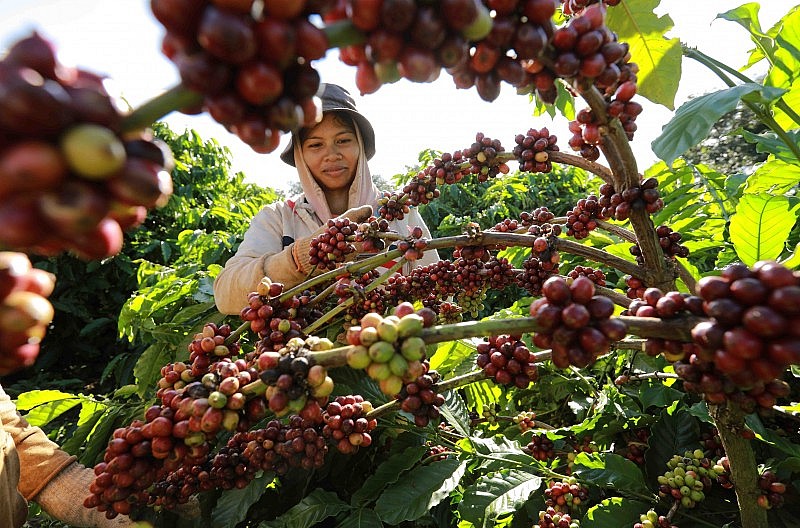According to Commodity Exchange Vietnameseization (MXV), ending the trading week of November 6 – 12, green dominated the price list of industrial raw materials. In particular, coffee prices increased by 2.11% for Arabica contract in December 2023 and 2.07% for Robusta contract in January 2024. This is the highest price in the past 5 months.
Tight supply in the short term, leading to the lowest Arabica inventory on the Intercontinental Commodity Board (ICE) in more than 24 years, has supported price increases. On the contrary, the prospect of new crop coffee supply in Vietnam contributes to softening prices.
Last week, standard Arabica inventory on the ICE-US Department decreased by 57,774 bags of 60kg, a record decrease in a week, bringing the total number of coffee in storage currently to 302,235 bags. This is the lowest standard inventory level ever recorded since mid-April 1999.
However, coffee harvesting activities in Vietnam are stable, increasing expectations of new crop supply coming to the market soon. This alleviates concerns about levels export previously low and contributed to stabilizing inventory on the ICE-EU Department, which is fluctuating around 40,000 tons.
On the domestic market, coffee prices are flat and stable at a fairly high level. Presently coffee price The average price in the Central Highlands provinces is about 58,100 VND/kg, the highest purchase price is 58,300 VND/kg. The Vietnam Coffee and Cocoa Association predicts that the 2023-2024 coffee crop will be harvested later than the previous crop. Some localities such as Gia Lai, Kon Tum, and Son La have harvested coffee earlier in late October and early November and will harvest in full at the end of December 2023.
The Vietnam Coffee – Cocoa Association informed that in the 2022-2023 crop year (October 2022 to September 2023), there will be more difficulties than advantages, but with the dynamism and efforts of farmers and the community, According to the business community, Vietnam’s coffee export results reached 4.08 billion USD, the highest in the export history of the coffee industry.
Regarding the consumption market, the EU is still Vietnam’s largest coffee export market in the 2022-2023 crop year with a volume of 615,364 tons, worth more than 1.4 billion USD, down 7.1% in volume and 0.3% in value compared to the previous crop year. Within the EU, coffee exports to Germany reached 203,317 tons (down 5.9%), Italy reached 146,684 tons (up 6%), and Spain and Belgium decreased by 13.1% and 42.7%, respectively.
The EU market is accounting for an average proportion of 39.3% (in output) and 37.6% (in value) of Vietnam’s total coffee exports. With such export volume, Vietnam is the second largest foreign coffee supplier to the EU, second only to Brazil.
However, recent forecasts suggest that to “repress” the decline in exports and keep Vietnam’s coffee export market share in the EU market in the coming time, there will be big challenges. Especially from January 1, 2024, when businesses export coffee to the EU market, they will not only have environmental regulations but also labor regulations.
| Coffee exports aim to be sustainable in association with green growth and environmental protection (Photo: VNA) |
To develop sustainable coffee associated with green growth, protect the environment, protect nature, and minimize the impact of climate change, it is necessary to have a specific action program and synchronous coordination. between ministries, branches, state management agencies, localities, international organizations and businesses.
First, the coffee industry must have an action plan to adapt to anti-deforestation and forest degradation regulations (EUDR), Carbon Border Adjustment Mechanism (CBAM) and carbon certificates of the European Union (EU). ) just issued. In particular, the EUDR stipulates that coffee and cocoa cannot be imported into the EU if grown on deforested land (dated from December 31, 2020 to present).
According to the Vietnam Trade Office in Belgium, coffee exporters need to apply digital technology to enforce the EU’s anti-deforestation regulations in the coffee industry. Accordingly, data collection is necessary at every stage of the supply chain if Vietnamese coffee producers and exporters want to maintain operations in the EU market.
However, the most difficult thing that the Vietnamese coffee industry is currently facing is that there is no database to trace the origin of coffee to the garden. Meanwhile, EUDR requires 100% of some Vietnamese agricultural products, especially coffee entering Europe, to have GPS information to each garden, based on which confirmation of the risk of causing harm to Europe is required. deforestation using remote sensing monitoring systems.


